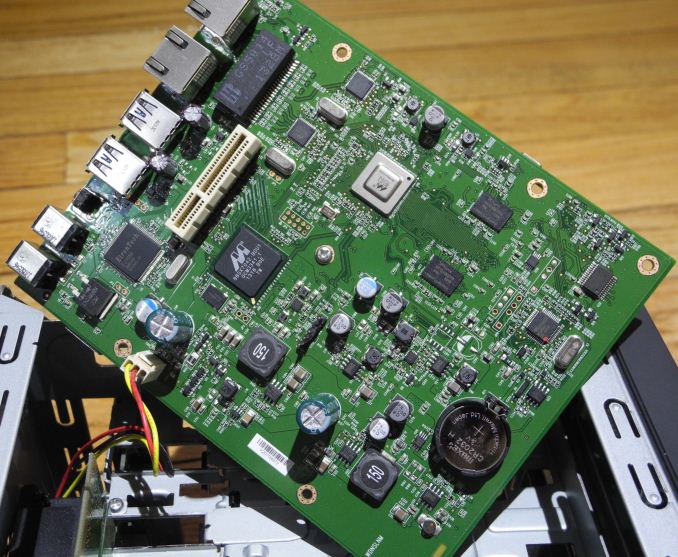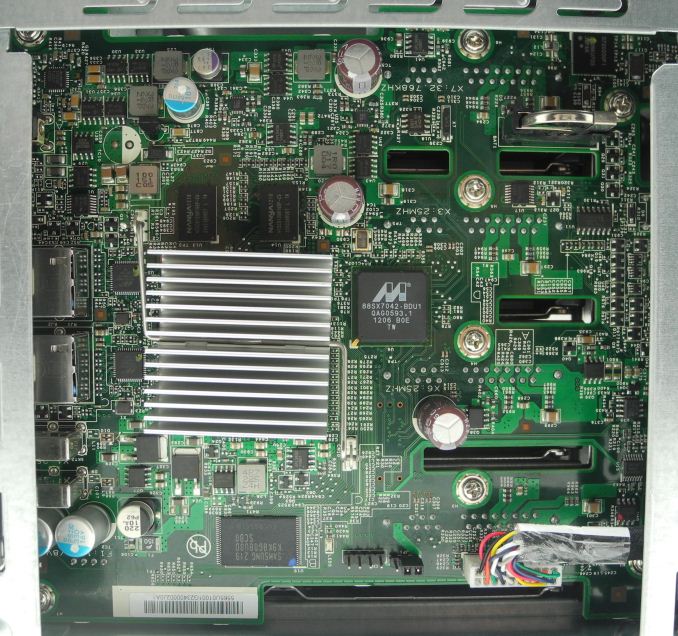Western Digital My Cloud EX4 and LenovoEMC ix4-300d Home NAS Units Review
by Ganesh T S on February 26, 2014 2:30 AM EST- Posted in
- NAS
- Western Digital
- LenovoEMC
Teardown and Platform Analysis
The internal specifications, as well as the available I/O ports, of the LenovoEMC ix4-300d and the Western Digital My Cloud EX4 were tabulated in the previous page. Both the NAS units come with 90W power bricks (100 - 240V AC-in, 19V @ 4.7A DC-out). Despite having two GbE ports, only one RJ-45 cable is supplied in each package. While the EX4 doesn't have any I/O ports in the front, the ix4-300d has a USB 3.0 port beneath the power button. Moving to the rear, the WD EX4 has two power jacks, two USB 3.0 ports, a recessed reset button and two GbE ports at the top. Perforations for a single large fan make up the lower segment. On the other hand, the ix4-300d has two USB 2.0 ports, two GbE ports, a recessed reset button and the DC jack on the left side of the rear face, while a single large fan makes up the right side.
On the i4-300d, the chassis cover has to be removed in order to add or replace hard drives. This is an acceptable solution since the unit doesn't have hot swap capability. The drive caddy is interesting in the sense that the hard drives don't need to be secured with screws. Rather, the caddy has 'screws' which slot into the appropriate drive holes. The caddies have to be pulled out with force, and the whole drive addition / replacement experience, though fast, is not entirely a pleasant one. It would be preferable to have a traditional caddy to support both 2.5" and 3.5" drives. The EX4, on the other hand, completely does away with the caddies. The hard drive slots are sized exactly to fit in a 3.5" drive in the correct orientation. There are no drive caddies or screws to bother with. Despite the Marvell ARMADA XP in the ix4-300d being clocked only at 1.3 GHz and the Kirkwood SoC in the EX4 being clocked at 2.0 GHz, it is the ix4-300d which has a heatsink on top of the SoC. The EX4 just opts for open air cooling.
Western Digital My Cloud EX4 Motherboard
The Marvell 6282 is a well-known entity in NAS circles. We have seen its 1.6 GHz lower-clocked cousin in the Synology DS211+ and the Netgear NV+ v2. As a recap, the SoC configuration of the 6282 is provided below.
Marvell Kirkwood 6282 Block Diagram
The WD EX4 has two GbE ports, and we can see that the 6282 has two native GbE MACs on-board. The other interesting components on the board are the Marvell 88SX7042 (4-port SATA to PCIe x4 bridge), the Etron EJ168A (2-port USB 3.0 to PCIe x1 bridge) and two Marvell 88E1518 GbE transceivers. Even considering the fact that the SATA SERDES lanes on the 6282 were reconfigured for PCIe (unlikely, since there is no reference in the Marvell documentation to that being possible), we are left with an imbalance: A total of five PCIe lanes are needed for the peripherals, while the SoC only provides two. It is simply not possible for the system to support all peripheral I/Os are full speed. What does this have on routine performance? We hope to address this in the performance sections of the review.
Moving on to the ix4-300d, we find it to be based on a dual-core Marvell ARMADA XP dual-core solution, the Marvell MV78230. A block diagram of the high-end ARMADA XP solution is given below.
Marvell ARMADA XP Block Diagram
The main difference between the MV78230 solution and the 78460 represented above are the number of cores (2 instead of 4 v7 CPUs), core frequency (1.3 GHz instead of 1.6 GHz), L2 cache size (1 MB instead of 2 MB), DRAM buswidth (32 instead of 64), number of GbE ports (3 instead of 4) and number of SERDES lanes (7 instead of 16). A photo of the main components of the ix4-300d motherboard is shown below.
LenovoEMC ix4-300d Motherboard
The Marvell 88SX7042 SATA to PCIe bridge again makes an appearance. The four SATA ports connect to the daughterboard and interface with the disks in the drive bays. On the other side, this bridge connects to four SERDES lanes (configured as PCIe) on the MV78230. On the top right of the picture above, a Renesas µPD720200A USB 3.0 to PCIe 2.0 x1 bridge can be seen. It takes up one more SERDES lane. This still leaves a couple of spare SERDES lanes, as the only other I/Os (two USB 2.0 ports and two GbE ports) have direct interfaces on the SoC. On the whole, the platform design of the ix4-300d seems to be able to guarantee exploitation of the full performance from all connected peripherals simultaneously. The performance sections will prove whether the inferences from the board design translate to performance in real-world situations also.


























38 Comments
View All Comments
Icehawk - Thursday, February 27, 2014 - link
Raid 5? Why bother - the point of these cheap and slow devices IMO is for simple raid mirroring. I have an old WD 2 device job and it is slow as molasses but I don't really care as it is used as an archive dump to hold stuff I'd hate to lose.chizow - Thursday, February 27, 2014 - link
Accurate review from what I saw, I have the 2-bay version of the Lenovo/iomega NAS and the WD MyCloud EX4 as well. The hardware, mainly the single core CPU in the WD definitely hold it back especially with multi-client accesses, but I think the key feature that I did not see mentioned at all is the MyCloud's excellent cloud functionality. It also has a very easy to use smartphone app that allows you to access the NAS contents securely from anywhere with just a single sign-on username, no need for IPs or hostnames, port-forwarding, SSH or anything else that would scare off the average home user.The Iomega units are solid for their price, but they definitely aren't as fast as the Qnap or Synology units of the world, but the Iomegas can be had for a fraction of the price. Good entry-level home NAS units for those that have extra HDDs lying around and want to provide centralized network storage.
Frolictoo - Sunday, March 2, 2014 - link
I still can't believe that vendors use SATA II connectors when most new NAS drives come in the SATA III flavor. If legacy reasoning is the case then why not add both options; SATA III is backwards compatible with SATA II. I have just built a new NAS using all WD RED drives on a RAID 10 array and I am truly satisfied with the impressive performance gain over the older SATA II counterparts.M/2 - Sunday, March 2, 2014 - link
I've never understood consumer grade NAS drives. They're slow and problematic. Why not just set up a 4-bay RAID attached to a small computer and get RAID5 speeds over the network? I've got a 4-bay, USB3, RAID5 box (~$250 plus the cost of the drives) connected to a MacMini. Even on USB3, I get 250 Mb/s read/writes, Voila! 6X faster than NAS!Assuming you're using the Mini for other things than just network storage, the cost is about the same. There's also a dozen or so little MicroPC's with USB3 for ~$300-400 that you can do the same thing with if you're doing Windows. I love the MacMini because I can do everything I need over Remote Desktop, I never have to touch the Mini. You can put it in any dark corner and do everything remotely. Mine is in the very back of the entertainment center, it's just one more HDMI input on the AV receiver. If I need a big screen (iTunes, photos, movies) it's always there. Otherwise, it's there for remote clients including, laptops and AppleTV's. Try playing music or movies from a NAS drive! Yes you can do it, but it's not plug and play. This isn't intended to be an advert for Mac's, I just like my setup. You can do the same thing with a MicroPC.
What am I missing? Be nice, I'm not an IT guy.
chizow - Monday, March 3, 2014 - link
2 main reasons I can think of that prevented me from going this route:1) Power consumption: if you have something that you could repurpose for a NAS server, it's probably going to be old and power hungry. No way I would want one of my old X58 rigs powered 24/7 just to file server on my network. The WD MyCloud EX4 for example uses only ~15W idle and 30W under load. Huge difference.
2) Price: There are definitely low-power options available now, even something like a NUC connected over USB 3.0 wouldn't be a terrible option, or a mini-ITX box. But then you are talking real money, and that's before you take the drives into account.
Consumer-grade NAS boxes are often good enough, especially if you aren't asking a whole lot of them. I use mine to access shared DVRed shows from multiple PC clients wirelessly over the network as well as backing up data on my client machines, tablets, smartphones and it works well enough, provided I don't ask too much of it at once.
M/2 - Monday, March 3, 2014 - link
re: Power consumption... You got my curiosity going, a Mac Mini consumes 11W in idle mode (configured for wake on LAN). Mine has SSD's (RAID0 :) ), so it starts quick. I'm using a Dyconn Quartz4 which sleeps, there's no spec, but I'm assuming sleep mode must low, 4-5W? at most it's the same as a NAS.... so not much difference (at least to me)Re: NUC --- that's the cheaper option, except for one thing, it's Windows which is a pain in the *ss to manage ( for home use anyway, IMO, I made the switch about 5 yrs ago, never looked back) --- Regardless... I'm assuming the Mini is $0 added cost since I use it for other stuff besides network storage.
RAYBOYD44 - Monday, March 3, 2014 - link
John . even though Eleanor `s remark is super, last week I got BMW M3 after having made $6301 this last 5 weeks and over 10-k lass-month . this is certainly the best-work I have ever had . I actually started nine months/ago and straight away made myself over $70, p/h . svanel86 - Monday, March 3, 2014 - link
Since i owned a ix2-200d and a ix4-200d(free swap after my ix2 gave up and failed its own disks) i can attest you should run when offered the chance to get a lifeline -based device. If you activate the idle spin-off there is a very real chance the disk will be marked as dead by mdadm and since the disks die like flies in those due to the asthmatic fan(which spin on only if you get catastrophic temperatures) you are risking data daily if you use any powersaving option. The CIFS, NFS and AFS are very unoptimized, you can get unironically faster performance if you create a iscsi storage partition(which is the sole reediming feature of the former emc owned iomegas ixes, full vmware certification) and run a freenas within the storage area